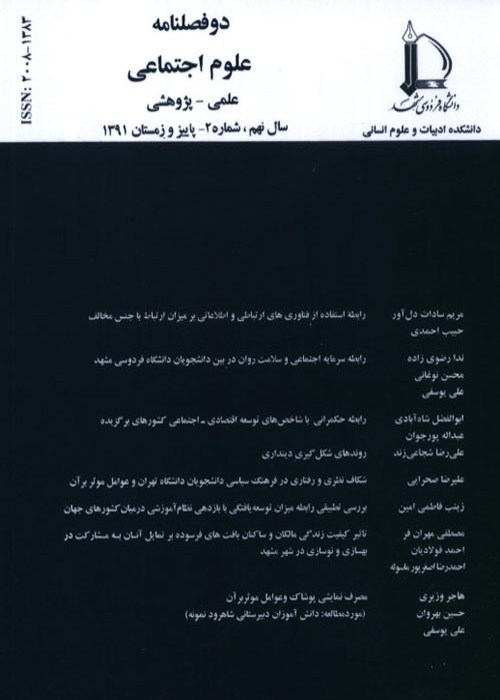The Structure of Ideology of Islamic Revolution during the First Decade after the Revolution: The content Analysis of Martyrs' Wills during the Iran-Iraq war
The Islamic revolution in Iran is the outcome of a long time Iranians struggle for in the last two decades, which succeeded by the leadership of Imam Khomeini in 1979 and constituted the Islamic Republic regime. A social resistance cannot succeed without having an account of events in the past, present, and future. In other words, any revolution needs an ideology. Islamic Revolution was an example of this case.In the 1970s, plenty of young Iranians who held an ideology joined the Islamic Revolution and had a significant role in its success. When in 1980, Iraq invaded Iran, these young people where the majority of volunteers in war fronts.In Iran, Beliefs and values during Iran-Iraq were particular, and values like sacrifice, unity, and sympathy were strong.The content analysis of wills by martyrs of the war helps to understand how they thought and believed. These wills are different from ordinary wills, which include debts, payroll, asking for mercy, and advice for spending one-third of the wealth of the willful. In the wills of Iranian martyrs, a religious-political atmosphere is dominant.
Ideology is one of the most disputing concepts in the social sciences. Conventionally, ideology is a closed set of governing ideas in social and political actions. In social sciences, usually ideological actors are considered people who follow principles of doctrine without any question. Examples of this take are often religious cults. The main idea here is intensity in conformity with a system of ideas.When people believe in an ideology, they feel it is an external phenomenon. It is the outsider who feels coercion in accepting the beliefs. People who believe in ideology have a strong collective identity. They may ignore other systems of ideas for this reason.Ideology is a system of social beliefs, distinction of ideology from political ideologies (Rajai 1975). Focusing on common interest and shared emotions can be the particular character of ideology. They justify some forms of action and reject some other vehemently. They are more organized and more oriented comparing to social beliefs.We believe that is a system of ideas and explicit judgments that are organized. It justifies, interprets and explains the social position of a group or society. Ideology is inspired and influenced by values. So they suggest specific orientation for the group or society. Then, based on this definition, ideology is a total integrated and consistent system of perceptions and opinions inside a society.
This research is done using the content analysis method that examines themes in the texts by quantification. We studied two thousand pages; each contains three hundred words from a complete set of martyrs wills gathered by the responsible organization. The studied texts are selected by systematic random sampling.After selecting texts, we read them and gave codes to all themes. The codes aggregated to form second-order codes. In the last phase, final codes emerged who may include some second-order codes.
Among 35362 recorded themes, the largest category was related to political affairs (46.55 percent). Then there were themes related to the cultural affair (39.60 percent), and the third place was social affairs with 13.83 percent of the total. The most frequent political theme is martyrdom and leadership. Revolution, resistance and the war has the next ranks. The most critical element in political behavior is sacrifice and life dedication and readiness for serving the leader. Related to cultural affairs, we found 14007 points in the sample, which is 39.6 % of the total. The main categories in this field are being oriented to God, following Imams, praying.
This study showed that the martyrs' will portray a right and wrong picture of war. They consider themselves in the right front and at its maximum level, consider it as a mystical practice. The martyrs, in the political category, point to martyrdom and Valayat. In the cultural category, they point to the centrality of God and Imamat. In the social category, family, unity, and integrity were their most concerns.Regarding these results, the ideology of the Islamic revolution during its first decade was an almost equal combination of political, cultural, and social dimensions in which the political dimension was a little more robust. The martyrs as members of the military forces did not consider themselves apart from political issues. In fact in this period in the political dimension, leadership and obeying the leader were significant.
- حق عضویت دریافتی صرف حمایت از نشریات عضو و نگهداری، تکمیل و توسعه مگیران میشود.
- پرداخت حق اشتراک و دانلود مقالات اجازه بازنشر آن در سایر رسانههای چاپی و دیجیتال را به کاربر نمیدهد.


